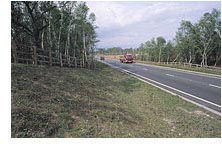|  This
analysis describes the characteristics and scale of the transport
sector and its impacts on the delivery of nature conservation
objectives in England. It gives English Nature's objectives for
the sector and sets out our three priority actions for 2001-2003.
We also identify the key organisations and actions needed to influence
policy and its delivery. This
analysis describes the characteristics and scale of the transport
sector and its impacts on the delivery of nature conservation
objectives in England. It gives English Nature's objectives for
the sector and sets out our three priority actions for 2001-2003.
We also identify the key organisations and actions needed to influence
policy and its delivery.
We outline the roles of the key players and shapers within the
sector. The dominant influences in this sector are the European
Union (EU), central and local government, the Highways Agency
and local highway authorities, Railtrack and other transport promoters
and lobby groups.
We examine the key socio-economic and political factors that
shape the sector; these include transport's contribution to the
national and local economies, its role as a major employer, people's
reliance on cars and road infrastructure, and the growing consensus
over the need for more sustainable use.
We analyse the positive and negative impacts of the sector on
nature conservation. Whilst the analysis identifies the range
of direct and indirect adverse effects on biodiversity such as
the loss and fragmentation of habitat, it also recognises that
there can be environmental gains through opportunities for biodiversity
management and enhancement. The transport sector is a key component
of all regional economies. In environmental terms, the south of
England, and in particular the south east and parts of the Midlands
are the main pressure points, although there is increasing demand
for new transport infrastructure across all Regions. |

